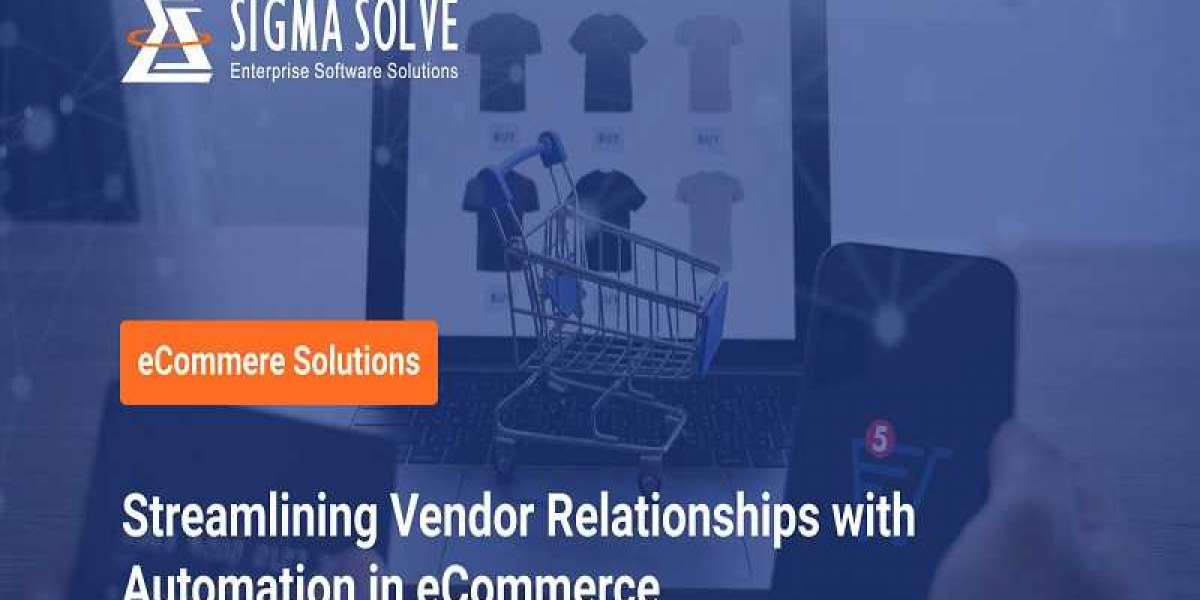Synopsis:
Do you know what the lifeline of eCommerce businesses is? eMarketer believes that 20.1% of retail shopping occurs through digital commerce solutions, while Forbes confirms the global eCommerce market is expected to total $6.3 trillion in 2024. Whether you need groceries, household products, electronics, or food, eCommerce is increasingly becoming a lifeline for urban and rural populations worldwide. But do you know what the lifeline of eCommerce businesses is?
This blog identifies the lifeline of eCommerce businesses, examines the role of vendor relationships and vendor management in eCommerce businesses, and explains how automation can streamline vendor relationships to optimize the supply chain, enhance operational efficiency, meet customers’ expectations, and expand revenue bottom line.
Vendor Management – An eCommerce Lifeline
Manufacturers who sell their products through eCommerce are not the only vendors that eCommerce businesses have. The logistics service providers, payment gateways, enterprise software solutions providers, and those who meet the smallest needs of the eCommerce businesses are all their vendors.
These vendors are a lifeline to eCommerce businesses and managing healthy relationships with vendors. These vendors ensure products reach customers on time. These vendors are instrumental in ensuring that the entire backend IT system functions at a peak. Efficient vendor management strategies are vital for eCommerce businesses for inventory management, order fulfillment, and keeping overhead expenses in check.
The Pain Points of Manual Vendor Management in eCommerce:
Anything manual is a bottleneck in the business world now. The demand for automation is increasing day by day across the sectors, more prominently in the eCommerce sector. The eCommerce sector heavily relies on manual processes, even though vendor management is one of the most critical aspects of the eCommerce business.
Due to manual vendor management, onboarding a new vendor is difficult and time-consuming. The communication gap between the eCommerce business and vendors could throw businesses out of gear. Notorious employees can compromise on compliance while onboarding vendors to invite penalties. Moreover, it becomes impossible to track vendor spending, which may incur financial losses. Therefore, the demand for automation for vendor management has been growing in leaps and bounds.
How Automation Can Revolutionize Your Vendor Relationships:
eCommerce has been one of the fastest-growing industries in the world. Therefore, managing vendor relations is one of the most critical aspects of driving success in the eCommerce industry. eCommerce businesses often struggle with regularly changing market demands, complicated procurement processes, and many vendors without AI ecommerce solutions.
Maintaining streamlined procurement processes and an efficient vendor management policy helps eCommerce save millions of dollars annually and expand its revenue base. Purchase invoice automation can transform vendor management for heightened accuracy and profitability.
Key automation technologies used in eCommerce:
Purchase Invoice Automation (PIA):
Leveraging OCR (Optical Character Recognition) and machine learning, PIA solutions can automate the data extraction from purchase invoices, eliminating manual entry and reducing errors. This accelerates invoice processing and ensures timely payments, strengthening vendor relationships.
Robotic Process Automation (RPA):
RPA solutions can automate repetitive tasks like order confirmations, shipment tracking, and vendor communication, freeing up valuable resources for strategic initiatives. This streamlined approach enhances vendor relationships by improving response times and reducing communication gaps.
AI-driven Vendor Selection:
By harnessing the power of generative AI algorithms in eCommerce, businesses can analyze historical data, forecast demand, and identify optimal vendors based on performance metrics and pricing. This data-driven approach ensures a strategic vendor selection process, fostering long-term partnerships.
Predictive Analytics:
AI-powered predictive analytics can identify potential issues with vendor performance, stock shortages, or delivery delays, allowing businesses to proactively address challenges and maintain smooth operations. This proactive approach strengthens vendor relationships by minimizing disruptions.
Automated Vendor Negotiations:
AI-driven negotiation tools can automate the vendor negotiation process based on predefined parameters, ensuring optimal pricing and terms. This streamlines the negotiation process and fosters transparency and trust with vendors.
Benefits of automation for vendor relationships:
Increased Efficiency and Reduced Processing Time
Automating tasks like purchase order creation, invoice data entry, and order confirmations dramatically reduces processing time.
This accelerated pace allows for faster vendor payments, improving cash flow and strengthening relationships.
Improved Data Accuracy and Reduced Errors
Manual data entry is prone to human errors, leading to invoice discrepancies and delays.
Automation eliminates these errors, ensuring accurate data exchange with vendors and reducing costly disputes.
Enhanced Visibility into Vendor Performance
Automated systems provide real-time data and analytics on vendor metrics like on-time delivery, quality, and pricing.
This increased visibility allows for proactive management of vendor relationships and quick resolution of issues.
Streamlined Communication and Collaboration
Robotic process automation can handle routine vendor communications, reducing delays and miscommunication.
Centralized vendor portals and automated alerts improve collaboration and information sharing.
Scalability and Resource Optimization
As businesses grow, manual vendor management becomes increasingly difficult to scale.
Automation enables seamless scaling of vendor processes without adding excessive workforce.
AI eCommerce Solutions: The Future of Vendor Management:
The confluence of artificial intelligence and eCommerce is turning out to be a magic potion that will overhaul the entire vendor management system for online shopping businesses. eCommerce businesses are keen to harness the power of machine learning, automation, and advanced algorithms to optimize vendor management and enhance overall efficiency in delivering goods to doorsteps.
Growth is paramount in the eCommerce sector, and whichever technology enhances prospects is desirable. AI fills that gap diligently and meticulously.
One of the most transformative applications of AI in vendor management is intelligent vendor selection. Through predictive analytics and data-driven insights, AI algorithms can analyze historical performance metrics, forecast demand, and identify the optimal vendors based on pricing, quality, and delivery timelines. This strategic approach to vendor selection can significantly enhance procurement processes and drive cost savings.
Moreover, AI-driven automation can streamline routine tasks such as purchase order processing, invoice reconciliation, and vendor negotiations. Businesses can automate these repetitive yet crucial processes by leveraging AI eCommerce solutions, reducing errors, and freeing up valuable resources for more strategic initiatives. As the future of digital commerce unfolds, AI will undoubtedly play a pivotal role in transforming vendor management, enabling eCommerce businesses to forge more robust, more efficient relationships with their suppliers.
Implementing Automation for Streamlined Vendor Relationships:
Let’s delve into the realm of streamlined vendor relationships powered by AI and automation solutions. In the bustling eCommerce marketplace, where time is currency and precision paramount, automation emerges as the silent conductor orchestrating harmonious interactions between businesses and their vendors. Here’s how it transforms the stage:
Identify Automation Opportunities
The first step is to analyze your current vendor management workflows and pinpoint the tasks and processes that are repetitive, time-consuming, or prone to errors. These are prime candidates for automation. Common areas include purchase order creation, invoice processing, tracking, and routine vendor communications.
Evaluate and Select Automation Solutions
Conduct a thorough evaluation of available automation solutions in the market. Consider factors like integration with your existing systems (e.g., ERP, CRM), scalability, vendor support, and total cost of ownership. It’s also crucial to assess the solution’s ability to handle your specific industry requirements and data formats.
Data Integration and Standardization
Seamless data integration is essential for successful automation implementation. Ensure that your data sources (e.g., vendor databases, invoices, purchase orders) are consistent, standardized, and compatible with the automation solution. It may involve data cleansing, format conversions, or implementing data governance processes.
Pilot Testing and Refinement
Before a full-scale rollout, conduct pilot testing of the automation solution with a subset of your vendor relationships. It allows you to identify and address potential issues, refine the processes, and ensure smooth integration with your existing systems. Continuously gather feedback and make necessary adjustments.
Training and Change Management
Implementing automation usually requires a cultural shift within the organization. Provide comprehensive training to your staff on the new processes and tools. Highlight the benefits of automation, such as reduced manual workloads and opportunities for upskilling, to address any concerns about job security or resistance to change.
By following these steps and working with experienced automation solutions partners, you can successfully implement automation solutions to streamline vendor relationships, improve operational efficiency, and gain a competitive advantage in the digital marketplace.
How Sigma Solve Can Help You Boost Vendor relationship?:
Sigma Solve’s automation solution recently witnessed upscaled order management and effective inventory management, along with helping Picses Healthcare free crucial working hours, diverting essential human resources towards better vendor management and superior customer experiences.
At Sigma Solve, we have been leveraging emerging and futuristic technologies, such as AI, ML, Cloud Computing, Automation, Virtual reality, and more, to develop digital transformation solutions for the eCommerce sector. These solutions enhance the ease of shopping and efficiency of entire order, vendor, dispatch, delivery management, and inventory management.
Sigma Solve is a proven technology partner for your digital transformation solutions. Consult our digital transformation experts and IT engineers to acquire new capabilities and set a progressive path toward building better healthcare systems. Call us at +1 954-397-0800 for consultation.
Original Source: Here







